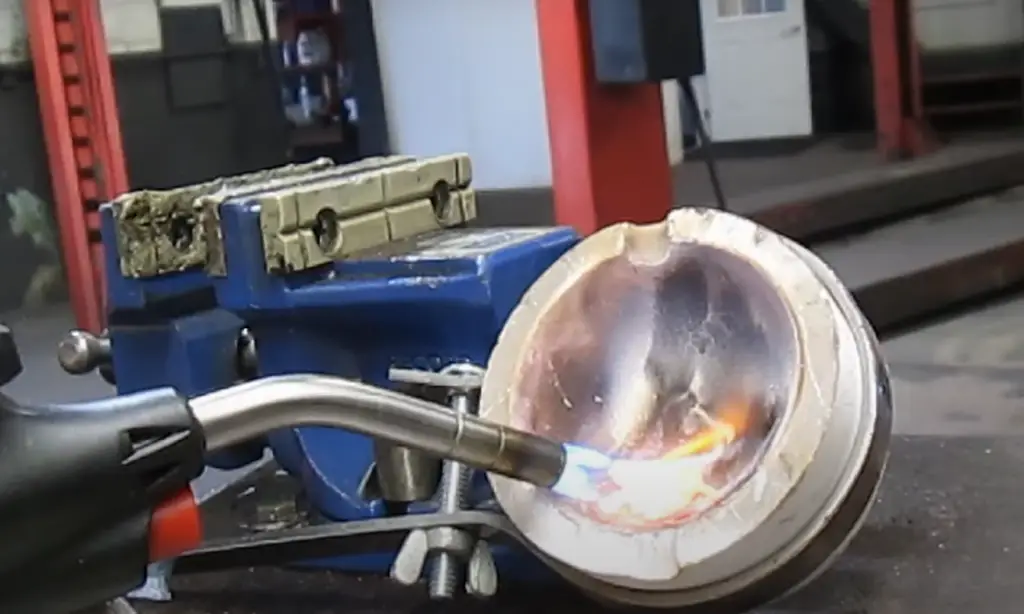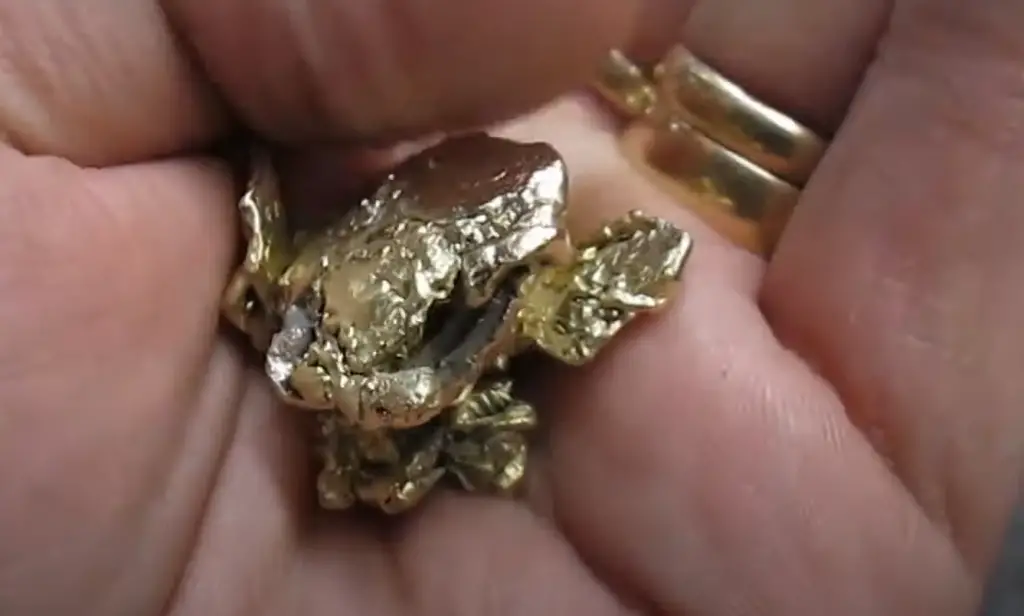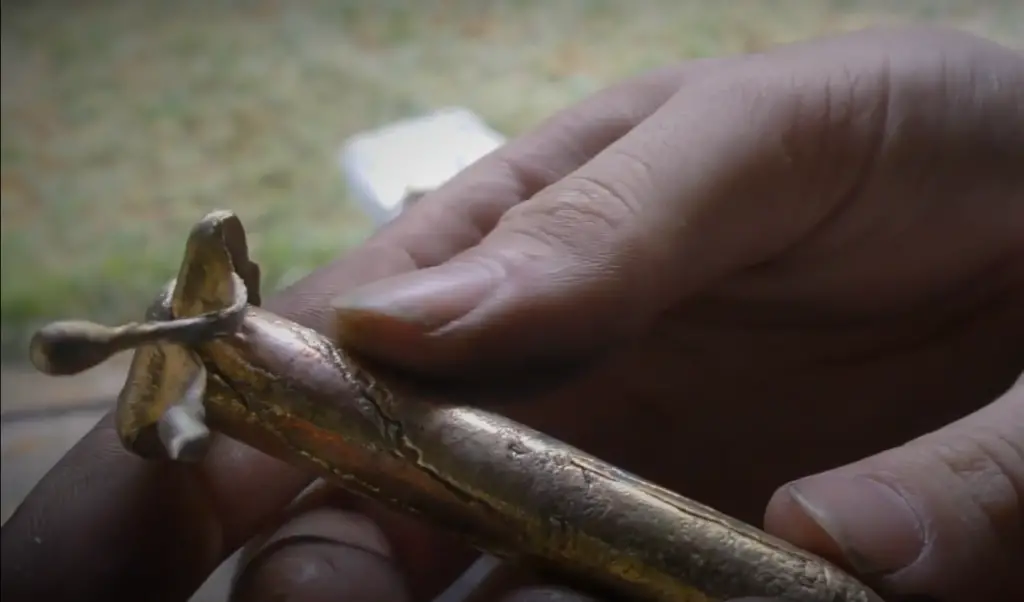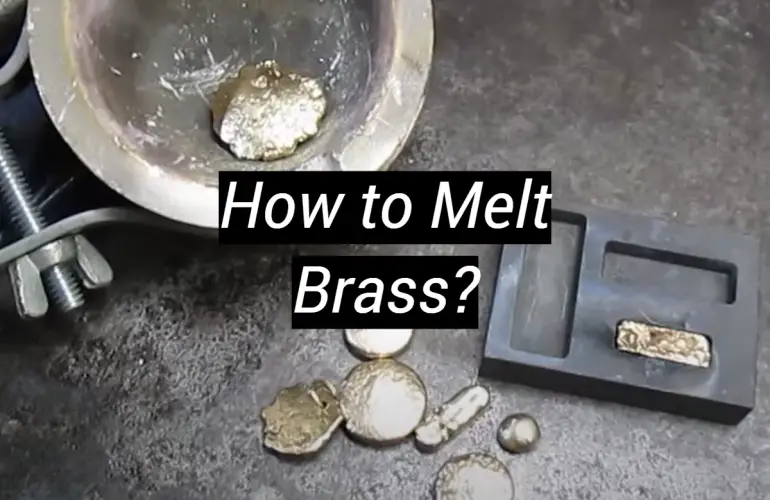Are you looking to melt brass, but don’t know how to get started? If so, you’ve come to the right place! In this blog post, we’ll explore some of the benefits of melting and working with brass.
Whether you’re interested in creating unique sculptures or designing intricate jewellery pieces, learning how to properly melt and shape brass can take your projects up a notch.
This article will show you what kind of torch or melting device is best for you, how to stay safe when melting metal at home, and some tips and tricks for achieving the best results.
How to Melt Brass?
The first step to melting brass is to choose the right torch or device for your project. The most common tools used for melting and working with brass are oxy-acetylene torches, propane torches, electric induction furnaces, and kilns.

Each of these devices has different benefits and drawbacks depending on what you’ll be using the metal for.
For example, oxy-acetylene torches work well for large pieces of metal because they can get hotter than propane torches and electric induction furnaces. However, kilns are better for small jobs like making jewellery or sculptures because the temperature is lower and more consistent.
Once you’ve chosen your melting device, you’ll want to make sure your workspace is safe and secure.
Finally, the best way to melt and work with brass is to use good technique. This means controlling the flame or furnace heat carefully and using appropriate tools to shape the metal when it’s hot.
Things You’ll Need
- Brass pieces
- Melting device
- Protective gear (gloves, goggles, face mask)
- Heat resistant container
- Welder’s apron
- Metal tongs
- Crucible
- Mould
Melting Process
- Place your brass pieces in a heat resistant container and put them inside of the melting device.
- Heat the metal until it’s molten, using the instructions for your chosen device.
- If necessary, use metal tongs to move the pieces around so that they melt evenly.
- When the brass is fully melted, pour it into a crucible or mold to shape it.
- Allow the metal to cool completely before handling it. [1]
Post-Melt Processes
Once the brass has cooled, you can begin to shape it into whatever form you desire. This could involve hammering, filing, sawing or some combination of those processes.
If you want to protect your brass project from rusting or getting dirty, you can use a sealant like wax or lacquer. You can also coat it in protective paint, especially if you’re going to keep it outside.
Warnings
Use the right safety gear when you work with hot metal. Make sure your workspace is safe and has good airflow.
It is never safe to try to melt brass without wearing the right kind of clothing that will not catch on fire. Also, always read the instructions for the device you are going to use before using it.
Be aware that when brass is melted, it can give off poisonous fumes. So make sure you have an area with good ventilation or use a machine that will remove the fumes.

Finally, always let the metal cool completely before handling it as hot brass can cause severe burns.
Precautions
When working with brass it’s important to take some safety precautions:
- Wear appropriate protective gear including gloves, goggles and a face mask.
- Ensure that your workspace is safe and away from any flammable materials or sources of heat or sparks.
- Heat the metal slowly and evenly using circular motions or moving in a figure eight pattern.
- Avoid stirring or agitating the molten metal as this can cause air bubbles or impurities to form.
- Allow the metal to cool naturally before handling it. This will avoid any potential burns or damage to the material.
- Use tongs or pliers to pick up the brass once it’s been heated. This will help keep your hands safe from burns.
- Keep an eye on the temperature and make sure it doesn’t exceed the temperature recommended for the grade of brass you’re using.
- Make sure that you have good ventilation in your workspace as when brass is melted, it can give off poisonous fumes.
FAQ
What’s the easiest way to melt brass?
The easiest way to melt brass is by using an electric furnace or propane torch. But you should always follow the manufacturer’s instructions when using these devices. You should also wear protective gear to stay safe.
How hot does brass need to be melted?
The temperature required to melt brass will depend on the grade of brass you’re using.
Can I use a home oven to melt brass?
No, it is not recommended to use a home oven for melting brass as the temperatures required are too high and can be dangerous. It is best to use a professional melting device such as an electric furnace or propane torch.
Can I melt brass with a candle?
No, it is not recommended to use a candle for melting brass due to the inadequate heat output and potential safety risks. Electric furnaces and propane torches are better suited for this purpose.
What is the best way to shape melted brass?
Once the brass has cooled and solidified, you can begin to shape it into whatever form you desire.
Common methods include hammering, filing, sawing or some combination of these processes. You should also use a sealant like wax or lacquer to protect the brass from rusting and dirt.
What safety precautions should I take when melting brass?
When working with brass, there are some safety precautions you should take. This includes wearing protective gear, making sure your workspace is safe, heating the metal slowly and evenly, avoiding agitating the molten metal, allowing the metal to cool naturally before handling it, and using tongs or pliers to pick up the brass once heated.
Additionally, make sure you have good ventilation in your workspace as when brass is melted, it can give off poisonous fumes.
Is brass hard to melt?
No, brass is not difficult to melt but it is important to ensure that the temperature does not exceed the recommended melting point for the grade of brass you are using.

Additionally, make sure to take safety precautions when working with molten metal and allow it to cool naturally before handling.
Can brass be melted with a propane torch?
You can use a propane torch to melt brass. But be careful not to make the temperature too high or it will melt the brass. Be extra careful when you are working with molten metal and let it cool down by itself before you touch it.
Is it safe to melt brass?
Yes, melting brass is safe if you follow some safety rules. You need to wear special gear and watch the temperature while heating the metal. Also, your workspace should have good ventilation because when brass is melted, it gives off poisonous fumes.
Can I melt brass with a soldering iron?
No, you should not use a soldering iron to melt brass as the heat is not sufficient enough. Use an electric furnace or propane torch instead.
Be sure to follow all safety precautions when working with molten metal and be mindful of the temperature so it doesn’t exceed the melting point for the grade of brass you are using.
Is burning brass toxic?
Yes, burning brass can be toxic. When you heat up brass, it emits hazardous fumes like zinc oxide and copper oxide which can be harmful if inhaled.
Make sure to have good ventilation in your workspace and always wear protective gear when dealing with molten metal.
Are there any other tips for melting brass?
Yes, here are some other tips for melting brass:
- Heat the metal slowly and evenly to prevent it from burning or bubbling.
- Avoid agitating the molten metal as this may cause splashing.
- Allow the metal to cool naturally before handling it, using tongs or pliers if needed.
- Use a sealant like wax or lacquer to protect the brass from rusting and dirt.
- Make sure you are aware of the melting point of your grade of brass so you don’t exceed it.
- Be mindful when heating up the metal as hazardous fumes may be emitted.
- Wear protective gear and take other safety precautions as needed.
- Make sure your workspace is safe and well-ventilated.
Does heating brass make it softer?
No, heating brass does not make it softer. In fact, heating the metal causes it to harden as its structure changes.
If you want to soften brass, you can anneal it which involves heating and cooling the metal slowly in order to change its structure and reduce its hardness.[2]
What are the benefits of melting brass?
Melting brass has several benefits. It can be used to create different shapes and sizes from a single block of metal, it can be mixed with other metals for different alloys, and it is also easier to cut or weld after being heated up. Additionally, heating and cooling the metal can anneal it and make it softer.
Melting brass is also a great way to recycle metal, as old pieces can be melted down and reused in new products. Finally, melting brass can create interesting textures and colours that are not possible with other metals.
How long does it take to melt brass?
It takes different amounts of time to melt brass, depending on how much metal you have and what kind it is. It also depends on the temperature. In an electric furnace at a temperature of 1,400 degrees Fahrenheit, it usually takes 10-15 minutes for one pound of brass to melt. If you are using a propane torch, it might take a little longer. Be careful to watch the temperature so it does not get too hot and melt your brass grade.
Why is it important to know the melting point of brass?
It is important to know the melting point of brass because if you exceed this temperature, you could melt the metal too quickly and cause it to bubble or burn.

Additionally, safety precautions should be taken when working with molten metal as hazardous fumes may be emitted. Knowing the exact melting point for your grade of brass will help you to avoid any potential risks or hazards.
Does melting brass require protective gear?
Yes, when you melt brass, you should wear protective gear like gloves, goggles, and a face mask. This is because brass emits hazardous fumes like zinc oxide and copper oxide which can be harmful if breathed in.
Additionally, safety precautions should be taken when working with molten metals in general. Make sure your workspace is safe and has good ventilation to avoid any accidents.
Do I need to clean the brass before melting?
It is important to clean the brass before melting it. This helps remove anything that could make the metal dirty and affect its properties. A wire brush can be used for this purpose.
Additionally, it is important to use a sealant like wax or lacquer after melting to protect the brass from corrosion. This will help make it last longer and be easier to work with in the future.
Do I need to cool the brass before handling it?
Yes, you should allow the brass to cool naturally before handling it. This is because molten metal can be very hot and cause serious burns.
Additionally, even when cooled off, brass can still be brittle and sharp so it is important to wear protective gear like gloves when working with it. It may also be helpful to anneal the brass before handling it, as this will make it softer.
Which type of furnace is best for melting brass?
Electric furnaces are usually the best option for melting brass. This is because they can reach the required temperature of 1,400 degrees Fahrenheit quickly and evenly.
However, if you do not have access to an electric furnace, a propane torch can be used in a well-ventilated area. Be sure to monitor the temperature carefully so you don’t exceed the melting point.
Should I use flux when melting brass?
Yes, it is a good idea to use flux when melting brass. Flux helps to keep the brass from rusting and keeps it clean. Additionally, it can help remove any unwanted scale from the surface of the molten metal.
There are some things you need to know before melting brass. You need to know the melting point of the brass, use protective gear, clean it, prepare it, and cool it down before handling it.
You also need to use an electric furnace or propane torch with flux. Let the brass cool down naturally before using it.
Are there any special techniques to use when melting brass?
Yes, there are some techniques you can use to help ensure that your brass is melted correctly. You should preheat the metal before putting it in the furnace, which will make it easier to melt.
Additionally, stirring the molten metal with a rod or spoon can help prevent any impurities from burning off. Lastly, you should use a thermometer to monitor the temperature and make sure that it does not exceed the melting point.
How can I tell if my brass was melted correctly?
Once the brass has cooled down, you can check it to see if it melted properly. It should be free from any dirt or marks and have a smooth surface. Additionally, look for any signs of slag or oxidation on the surface. If everything looks good, then your brass was melted correctly.
To melt brass properly, you need to know what you are doing and be prepared. But if you have the right tools and instructions, you can do it without any problems.

Make sure to wear protective gear, use flux, preheat your metal, monitor the temperature closely and cool it off before handling it. If done properly, you will have a great result!
What should I do if the brass is not melting properly?
If the brass is not melting correctly, then there may be a few issues that need to be addressed. First, check the temperature and make sure it isn’t too low or too high. If the temperature is correct, then you should check for any dirt or impurities on the surface of the metal.
If these things are present, you can use flux to help remove them. Additionally, try stirring the molten metal to ensure that it is melting evenly. If all else fails, you may need a new furnace or propane torch.
Useful Video: CAN YOU MELT BRASS IN A POOR MAN’S CRUCIBLE ???
Conclusion
There are two ways to melt brass: in a furnace and with induction heating. A furnace is a good way to get the temperature you want quickly, but induction heating requires more precise calculations. Even though they are different, safety is always the number one priority when doing either of these tasks.
You should always wear eye and ear protection, practise safe handling techniques, keep the area well-ventilated, turn off all power sources before cleaning up any project, and dispose of melted metal responsibly.
With a bit of preparation and research, you can have your brass melted safely and efficiently in no time! Good luck on your next melting adventure – we hope you find success!
References:
- https://www.ehow.com/how_8654474_melt-brass-home.html
- https://blog.thepipingmart.com/metals/basics-of-melting-brass-an-overview/






